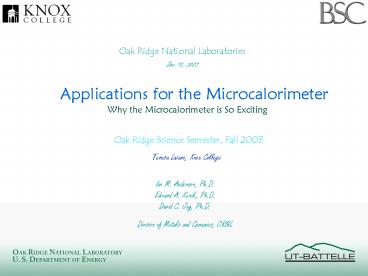Applications for the Microcalorimeter
1 / 17
Title: Applications for the Microcalorimeter
1
Applications for the Microcalorimeter
Oak Ridge National Laboratories
Dec 10, 2003
Why the Microcalorimeter is So Exciting
Oak Ridge Science Semester, Fall 2003
Teresa Lazarz, Knox College
Ian M. Anderson, Ph.D. Edward A. Kenik,
Ph.D. David C. Joy, Ph.D.
Division of Metals and Ceramics, ORNL
2
What the Microcalorimeter Does
3
X-Ray Spectroscopy
Characteristic X-Rays
The wavelength of the characteristic X-rays is
unique to the atom from which they come.
4
X-Ray Peaks in Spectra
The characteristic X-ray signals appear as peaks
(lines) superimposed on the continuum. These
peaks have fixed energies.
5
Comparing the Microcalorimeter toStandard
Techniques
6
Types of X-Ray Spectroscopy
Wavelength-Dispersive Spectroscopy (WDS)
Energy-Dispersive Spectroscopy (EDS)
7
m-Calorimeter Capabilities Summary
- Disadvantages
- Requires T lt 100 mK
- Relatively untested
- Small solid angle of collection
- Non-linear calibration unless corrected
- Advantages
- Resolution lt 15 eV
- Useful energy range
- Acceptable count rate (1000 cps with blanking)
- Speed
8
Disadvantages of Traditional Techniques
- EDS
- Low resolution (140 eV)
- Less than 2000 cps
- Lots of spectral artifacts
- Escape peaks
- Pulse pileup
- Electron-beam scattering
- Peak overlap
- Window absorption effects
- WDS
- Inferior collection efficiency
- Collects one wavelength at a time
- Slow
9
Advantages of the Microcalorimeter
Advantages of Traditional Techniques
EDS
WDS
- Good resolution (lt10 eV)
- Good resolution (5 eV)
- Superior collection efficiency
- 50,000 counts per second
- Collects from entire energy
- range simultaneously
- 1,000 counts per second
- Few spectral artifacts
- Fast
10
Using the Microcalorimeter
11
Main Application for Microcalorimeter EDS
Low Voltage Microscopy and Microanalysis
Why low voltage?
Smaller Interaction Volume.
Smaller excitation volume, more precision in
measurement!
50 nm
12
Spectrum Comparison
Dramatically more informative spectra! Very high
P/B ratios!
Spectrum of Galas using three different detectors.
BaTiO3 Spectra.
Spectra from Dale Newbury at NIST Boulder
13
Spark Plug Deterioration
14
Investigating Spark Plug Deterioration
15
Superalloys
CMSX4
g Face Centered Cubic (FCC) g Ordered FCC
16
Analyzing the Composition of CMSX4
Ni L 849
Al K 1487
17
Acknowledgements
- Ian M. Anderson, ORNL
- David C. Joy, ORNL
- Edward Kenik, ORNL
- H. T. Lin, ORNL
- Hans Norrell
- The Metals and Ceramics Division
- The ORSS/HERE Program
- Department of Energy






























